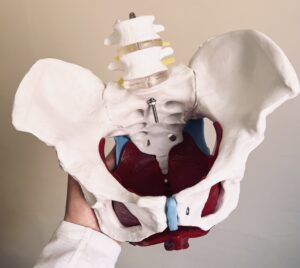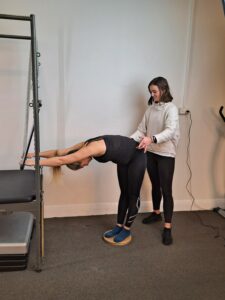Pregnancy Related Pelvic Girdle Pain
What is Pregnancy Related Pelvic Girdle Pain (PGP)?

Pelvic girdle pain (PGP) is a condition that is very common during pregnancy and in the post partum period and can impact a woman’s capacity to stand, walk, sit and complete everyday tasks. During pregnancy 33-55% of women report experiencing some degree of PGP before 20 weeks gestation and up to 60-70% by late pregnancy.
Why does pelvic girdle pain occur and will it go away after birth?
PGP occurs due to a combination of factors and are likely different for each individual
- Biomechanical changes including: an increase in load on the pelvic joints due to the weight of the baby; muscle weakness; postural changes
- Hormonal changes during pregnancy which cause soft tissue to lengthen and relax
- Previous musculoskeletal injuries or concerns such as low back pain
- Genetics
For the majority of women PGP symptoms ease after giving birth, however in 7-25% of women pain seems to persist into the post-partum period.
What are some of the symptoms of pelvic girdle pain?
PGP can cause a range uncomfortable and painful symptoms including:
- Pain over the front of the pubic bone (pubic symphysis) or in the back sacral region (sacroiliac joints)
- Pain in the area between the anus and vagina (perineum)
- Low back pain
- Pain radiating down into one or both legs
- Clunking or grinding sensations in the pelvic area
- Pain with everyday tasks such as sitting, standing, walking, going up and down stairs, in/ out of the car or rolling over in bed
- Can impact ability to care for toddlers and other children
What are some self management strategies that you can do at home?
It is important to firstly understand that although this condition can be painful, it does not pose any risk to your baby. Studies suggest that PGP is likely to worsen as pregnancy progresses which means that managing this type of condition as early as possible to work on strategies to keep pain and discomfort under control is vital.
Here are some tips to help manage your pain:
- Aim to keep your knees together, but not crossed: try sleeping with a pillow between your legs and perhaps under your tummy and try get in and out of the car with your knees together (e.g.try swivelling on a plastic bag!)
- Avoid standing on only one leg: try sitting down to put your pants or shoes on rather than standing; take stairs one at a time; try to take shorter steps when walking
- Avoid lifting and carrying heavy things on one side of your body, including babies or toddlers. Try to carry children evenly across your front when possible
- Avoid high heeled shoes
- Apply heat to painful areas
- Avoid specific tasks that increase your pain as you are able e.g. vacuuming, walking for exercise if this aggravates your pain
- Plan rests between more strenuous tasks
- Keep active within your limits eg. reduce your time walking if that is what aggravates your pain, try water-based exercise

How can physio help?
Our physiotherapists can assess your pain and determine if what you are suffering from is in fact PGP, diagnose the exact structure that is most likely causing your PGP to give an individualised approach, and rule out other conditions with similar presentations. If in fact you are suffering from PGP your physiotherapist can provide:
- Exercise prescription: to specifically strengthen the gluteal and/or deep abdominal muscles which support the pelvis
- Prescription of pelvic support garments
- Manual therapy to reduce pain
- Further individualised education regarding your condition and ways to help manage throughout your pregnancy and beyond.
If you are unsure if what you are experiencing is pelvic pain, call to our clinic on 8555 4099 or BOOK ONLINE for an assessment with one of our Physiotherapists.
Written by Caitlin Collenette


